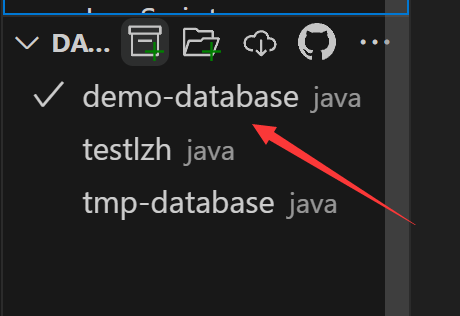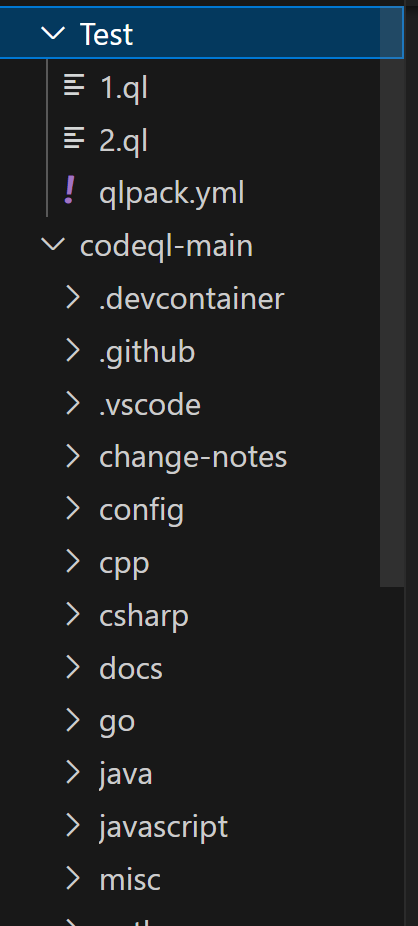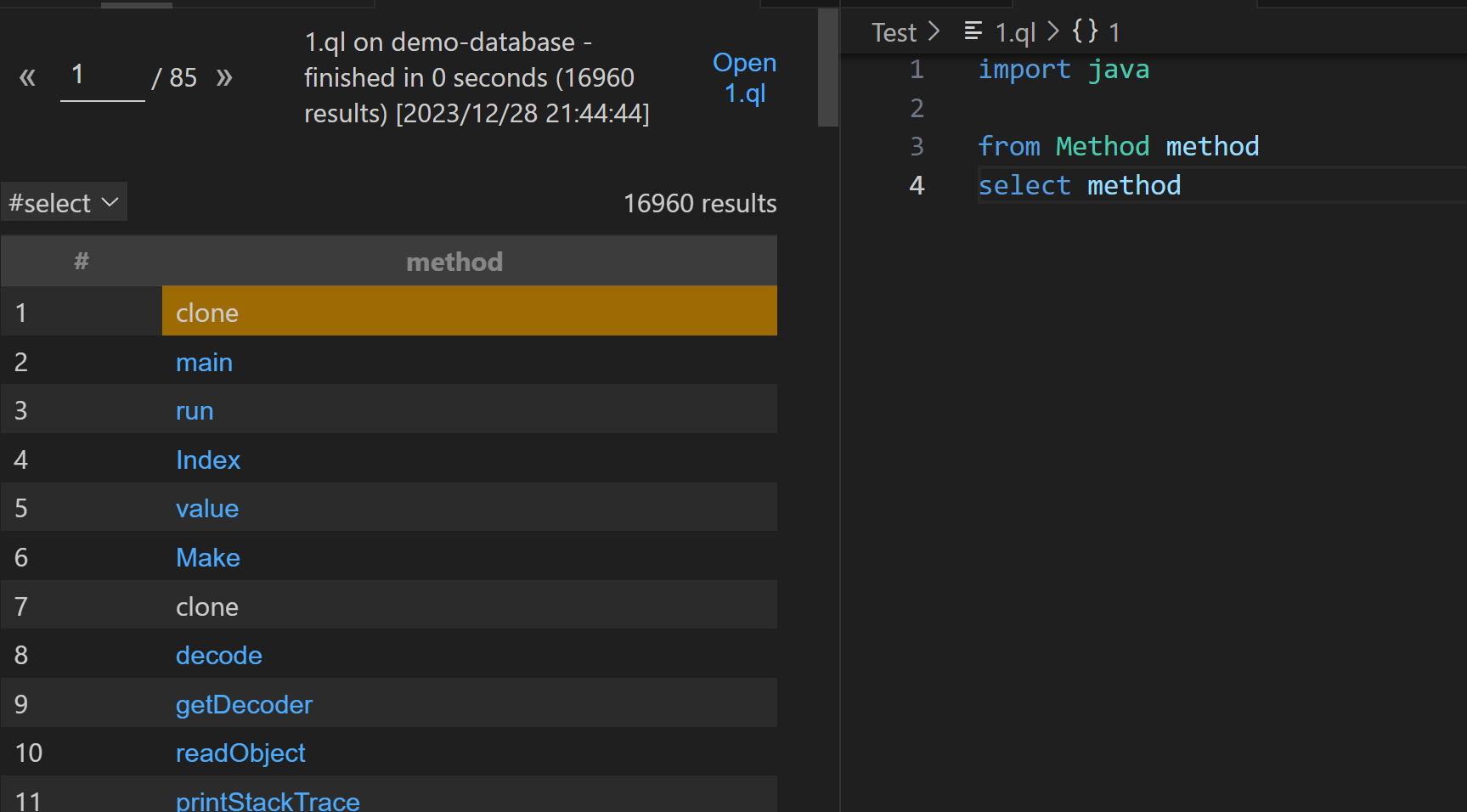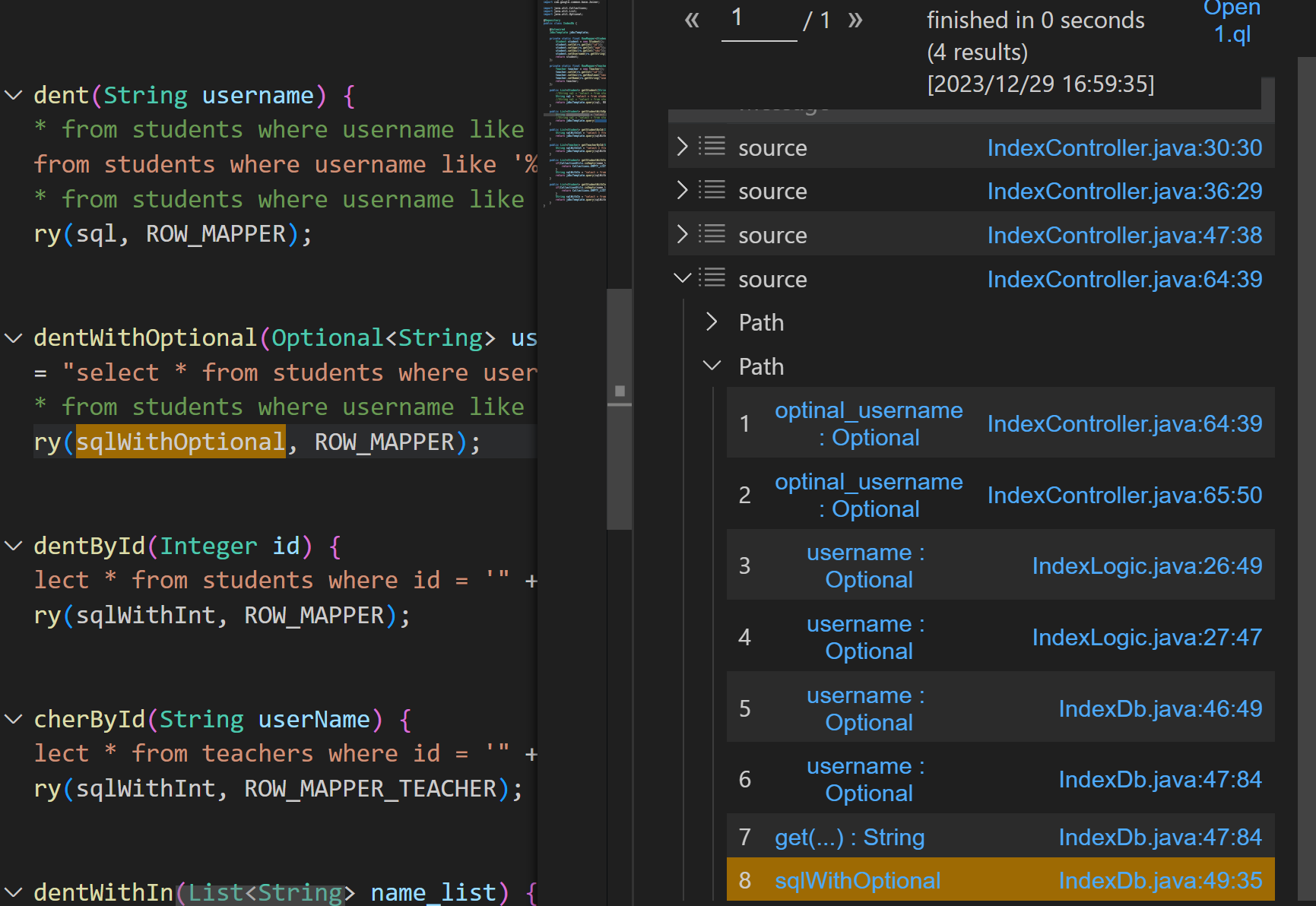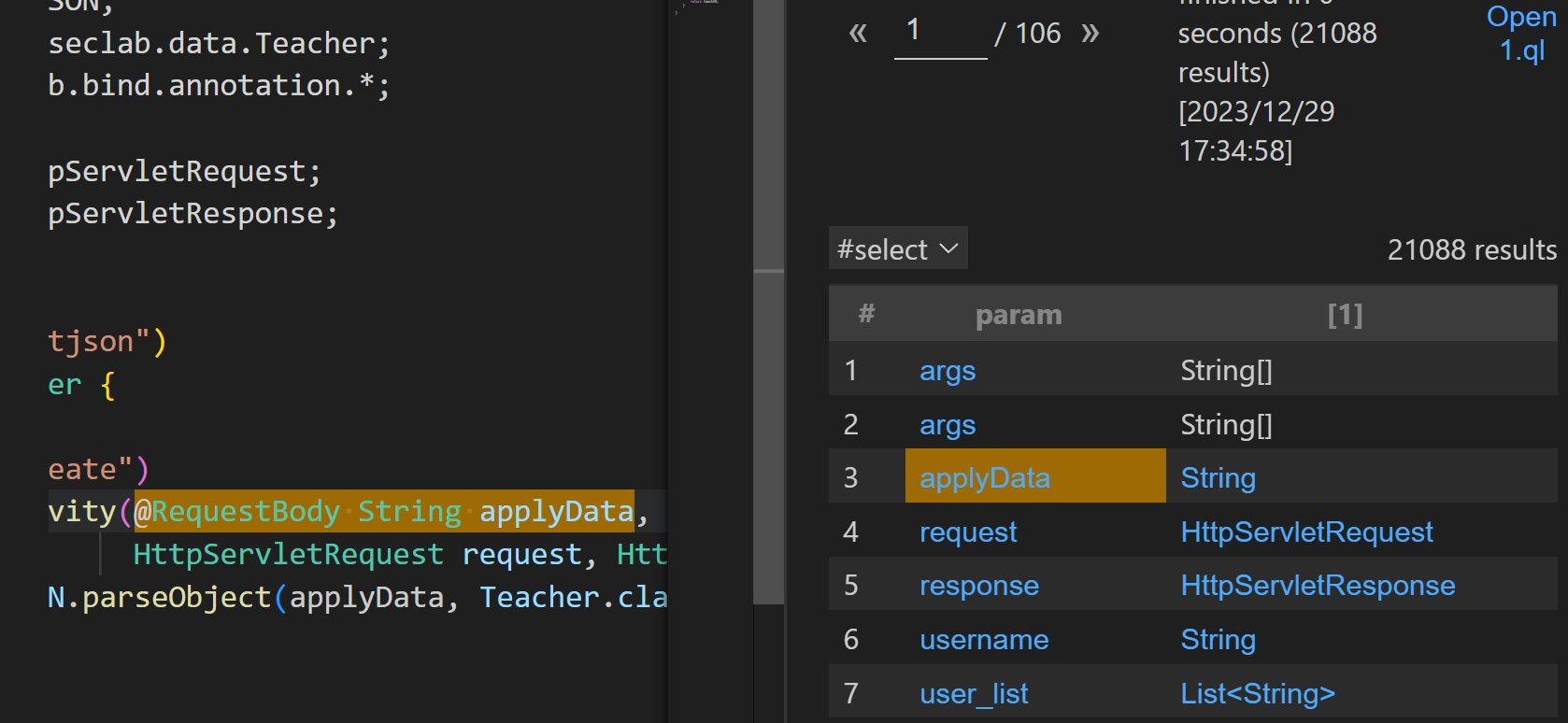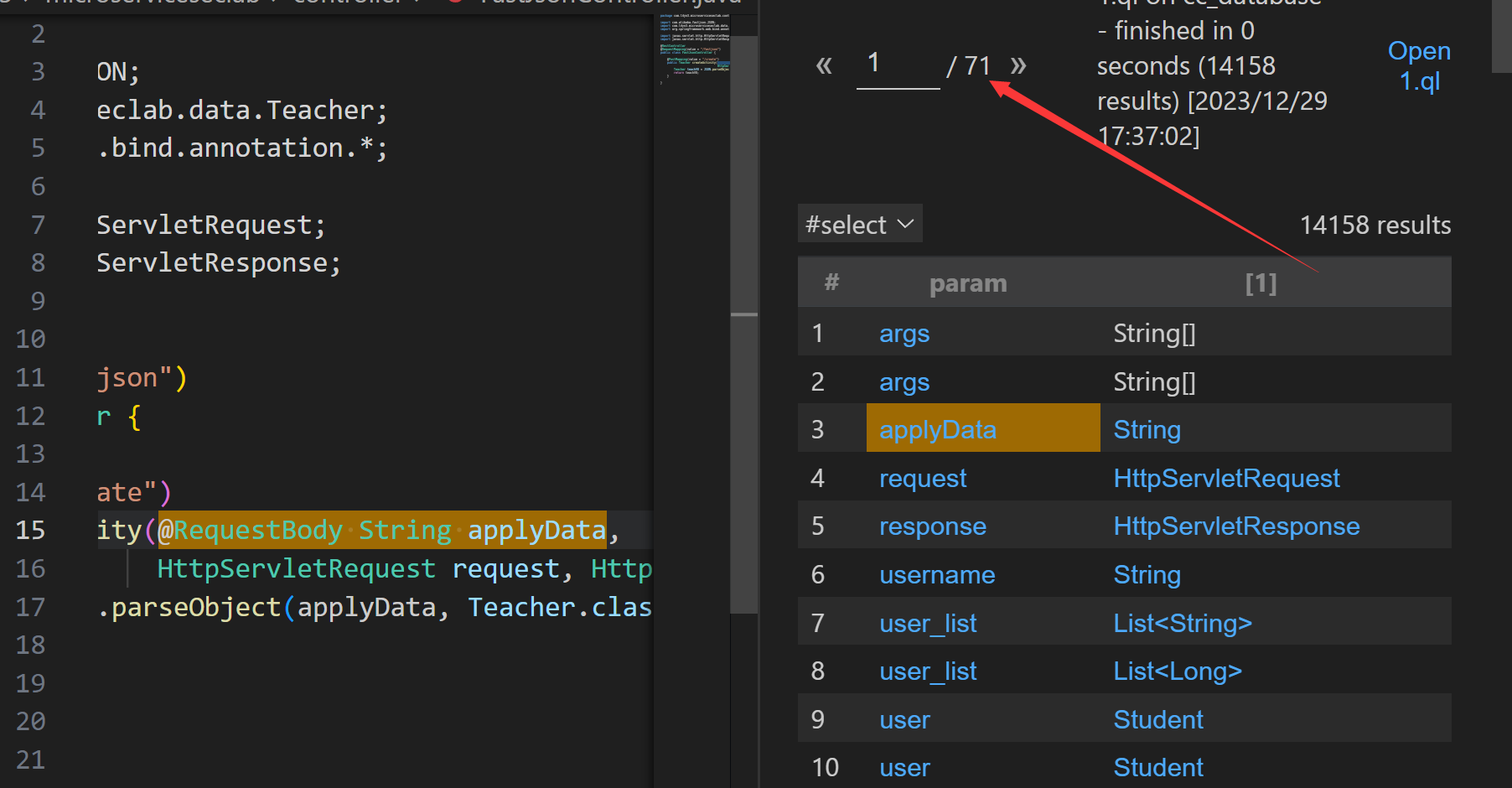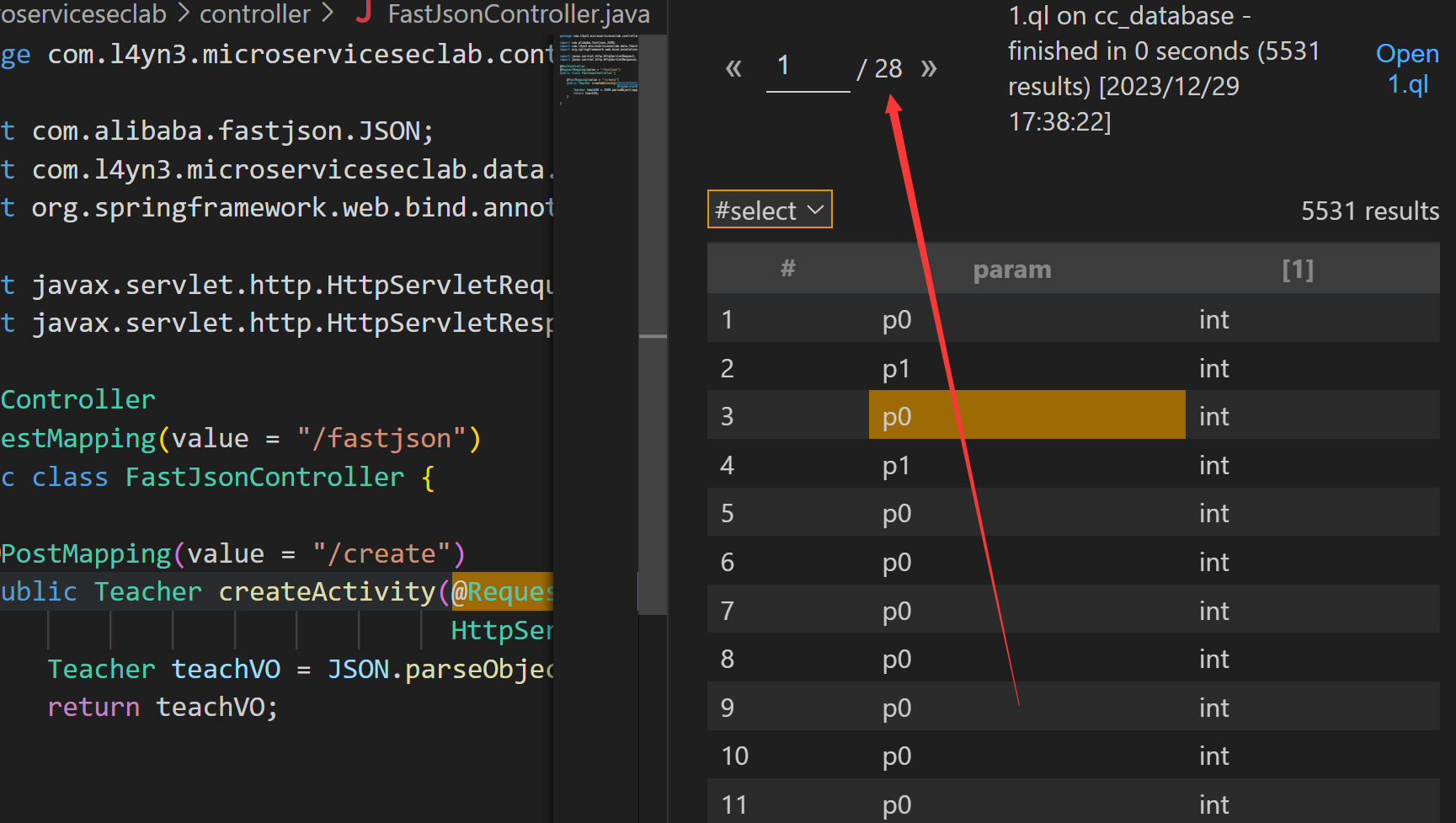https://www.freebuf.com/articles/web/283795.html (主要参考)
https://github.com/Firebasky/CodeqlLearn
粗糙的数据库生成 这里生成数据库的方法我用的是这个项目
https://github.com/ice-doom/codeql_compile
根据java源码构建数据库的方法
1 codeql database create "D:\google download\cc_database" --language="java" --source-root="D:\google download\micro_service_seclab-main" --overwrite
这里我用的例子是jar包
1 2 3 python .\codeql_compile.py -a D:\codeql_compile\ezjava.jar -d D:\codeql_compile\ezjava\BOOT-INF\lib codeql database create D:\codeql_compile\demo-database --language="java" --source-root=D:\codeql_compile\ezjava.jar_save_1703684740 --command="run.cmd"
一共两步就成功生成了数据库
然后导入数据库
先创建个文件夹 然后导入ql文件
qlpack.yml
1 2 3 name: example-query version: 0.0.0 libraryPathDependencies: codeql-java
然后写ql文件就行了
QL语言编写 基础查询 先是查询数据库中所有的类方法 这里的话是使用Method这个来进行查询
1 2 3 4 import javafrom Method method select method
查出数据库中所有函数方法
指定查询某个方法 1 2 3 4 5 6 import javafrom Method method where method.hasName("resolveClass" ) select method
如果要把其是什么类查询出来的化 就再加上一句话
1 2 3 4 5 import java from Method method where method.hasName("resolveClass") select method,method.getDeclaringType()
查询父类中子类的某个方法 1 2 3 4 5 import java from Method method where method.hasName("resolveClass") and method.getDeclaringType().getASupertype().hasQualifiedName("java.io", "ObjectInputStream") select method, method.getDeclaringType()
这里的话是查询ObjectInputStream这个父类中子类的resolveClass方法 这里的话就会有个疑问就是 他只能查询到隔一级的子类 隔两级的子类的resolveClass方法是查不到的
查询某个类中的某个方法被谁调用 Call和Callable
Callable表示可调用的方法或构造器的集合。
Call表示调用Callable的这个过程(方法调用,构造器调用等等)
过滤 方法调用
MethodAccess
一般是先查method,与MethodAccess.getMethod() 进行比较。
1 2 3 4 5 import javafrom MethodAccess call, Method method where method.hasName("resolveClass" ) and method.getDeclaringType().getAnAncestor().hasQualifiedName("java.io" , "ObjectInputStream" ) and call.getMethod() = method select call
这个是查找resolveClass这个方法被调用情况 我这样查是能查到 但是只能查父类下面差一级的子类
谓词(可以理解为函数) 和SQL一样,where部分的查询条件如果过长,会显得很乱。CodeQL提供一种机制可以让你把很长的查询语句封装成函数。
这个函数,就叫谓词。
1 2 3 4 5 6 7 8 9 import java predicate isStudent (Method method) { exists(|method.hasName("getStudent" )) } from Method method where isStudent (method) select method.getName(), method.getDeclaringType()
语法解释
predicate 表示当前方法没有返回值。
exists子查询,是CodeQL谓词语法里非常常见的语法结构,它根据内部的子查询返回true or false,来决定筛选出哪些数据。
设置Source和Sink
什么是source和sink
在代码自动化安全审计的理论当中,有一个最核心的三元组概念,就是(source,sink和sanitizer)。
source是指漏洞污染链条的输入点。比如获取http请求的参数部分,就是非常明显的Source。
sink是指漏洞污染链条的执行点,比如SQL注入漏洞,最终执行SQL语句的函数就是sink(这个函数可能叫query或者exeSql,或者其它)。
sanitizer又叫净化函数,是指在整个的漏洞链条当中,如果存在一个方法阻断了整个传递链,那么这个方法就叫sanitizer。
只有当source和sink同时存在,并且从source到sink的链路是通的,才表示当前漏洞是存在的。
设置source 1 override predicate isSource(DataFlow::Node src) {}
我们使用的是Spring Boot框架,那么source就是http参数入口的代码参数 ,在下面的代码中,source就是username:
1 2 3 4 @RequestMapping(value = "/one") public List<Student> one(@RequestParam(value = "username") String username) { return indexLogic.getStudent(username); }
在下面的代码中,source就是Student user(user为Student类型,这个不受影响)。
1 2 3 4 @PostMapping(value = "/object") public List<Student> objectParam(@RequestBody Student user) { return indexLogic.getStudent(user.getUsername()); }
在下面的代码中,source就是Student user(user为Student类型,这个不受影响)。
1 2 3 4 @PostMapping(value = "/object") public List<Student> objectParam(@RequestBody Student user) { return indexLogic.getStudent(user.getUsername()); }
Source设置的代码为
1 override predicate isSource(DataFlow::Node src) { src instanceof RemoteFlowSource }
这是SDK自带的规则,里面包含了大多常用的Source入口。我们使用的SpringBoot也包含在其中, 我们可以直接使用。
instanceof是codeql自带的语法
当然了上述语句并不是 完整可使用的语句 这是把我们等会完全的语句拿出部分进行解释讲解
设置sink 1 2 3 override predicate isSink(DataFlow::Node sink) { }
在本案例中,我们的sink应该为query方法(Method)的调用(MethodAccess),所以我们设置Sink为:
1 2 3 4 5 6 7 8 override predicate isSink(DataFlow::Node sink) { exists(Method method, MethodAccess call | method.hasName("query") and call.getMethod() = method and sink.asExpr() = call.getArgument(0) ) }
在这个语句中 call方法就是我们上文提到的 就是可以查询某个方法被谁调用了
注:以上代码使用了exists子查询语法,格式为exists(Obj obj| somthing), 上面查询的意思为:查找一个query()方法的调用点,并把它的第一个参数设置为sink (加黑的这句话就是上述代码中最后一段的解释)
在靶场系统(micro-service-seclab)中,sink就是:
1 2 3 jdbcTemplate.query(sql, ROW_MAPPER); //提前说明一下
因为我们测试的注入漏洞,当source变量流入这个方法的时候,才会发生注入漏洞!
当然了上述语句并不是 完整可使用的语句 这是把我们等会完全的语句拿出部分进行解释讲解
Flow数据流 设置好Source和Sink,就相当于搞定了首尾,但是首尾是否能够连通才能决定是否存在漏洞!
一个受污染的变量,能够毫无阻拦的流转到危险函数,就表示存在漏洞!
这个连通工作就是CodeQL引擎本身来完成的。我们通过使用config.hasFlowPath(source, sink)方法来判断是否连通。
比如如下代码:
1 2 3 from VulConfig config, DataFlow::PathNode source, DataFlow::PathNode sink where config.hasFlowPath(source, sink) select source.getNode(), source, sink, "source"
我们传递给config.hasFlowPath(source, sink)我们定义好的source和sink,系统就会自动帮我们判断是否存在漏洞了。
Source和sink配合查询结果 在CodeQL中,我们使用官方提供的TaintTracking::Configuration方法定义source和sink,至于中间是否是通的,这个后面使用CodeQL提供的config.hasFlowPath(source, sink)来帮我们处理。
1 2 3 4 5 6 7 8 9 10 11 12 13 14 class VulConfig extends TaintTracking::Configuration { VulConfig() { this = "SqlInjectionConfig" } override predicate isSource(DataFlow::Node src) { src instanceof RemoteFlowSource } override predicate isSink(DataFlow::Node sink) { exists(Method method, MethodAccess call | method.hasName("query") and call.getMethod() = method and sink.asExpr() = call.getArgument(0) ) } }
CodeQL语法和Java类似,extends代表集成父类TaintTracking::Configuration。
这个类是官方提供用来做数据流分析的通用类,提供很多数据流分析相关的方法,比如isSource(定义source),isSink(定义sink)
src instanceof RemoteFlowSource 表示src 必须是 RemoteFlowSource类型。在RemoteFlowSource里,官方提供很非常全的source定义,我们本次用到的Springboot的Source就已经涵盖了。
最终demo.ql
1 2 3 4 5 6 7 8 9 10 11 12 13 14 15 16 17 18 19 20 21 22 23 24 25 26 27 28 29 30 31 32 33 /** * @id java/examples/vuldemo * @name Sql-Injection * @description Sql-Injection * @kind path-problem * @problem.severity warning */ import java import semmle.code.java.dataflow.FlowSources import semmle.code.java.security.QueryInjection import DataFlow::PathGraph class VulConfig extends TaintTracking::Configuration { VulConfig() { this = "SqlInjectionConfig" } override predicate isSource(DataFlow::Node src) { src instanceof RemoteFlowSource } override predicate isSink(DataFlow::Node sink) { exists(Method method, MethodAccess call | method.hasName("query") and call.getMethod() = method and sink.asExpr() = call.getArgument(0) ) } } from VulConfig config, DataFlow::PathNode source, DataFlow::PathNode sink where config.hasFlowPath(source, sink) select source.getNode(), source, sink, "source"
注:上面的注释和其它语言是不一样的,不能够删除,它是程序的一部分,因为在我们生成测试报告的时候,上面注释当中的name,description等信息会写入到审计报告中。
(这个不能删 如果删了话再执行 就会生成不了下图中的alerts 不能清楚的看到source和sink之间的node了)
上述查询误报解决
在上述跑出的链子中 跑出sink是这个东西 但是呢这个参数是long类型的 不可能存在sql注入
这说明我们的规则里,对于List,甚至List类型都会产生误报,source误把这种类型的参数涵盖了。
我们需要采取手段消除这种误报。
这个手段就是isSanitizer。
1 2 3 4 5 6 7 8 9 10 11 12 13 isSanitizer是CodeQL的类TaintTracking::Configuration提供的净化方法。它的函数原型是: override predicate isSanitizer(DataFlow::Node node) {} 覆盖谓词 isSanitizer(DataFlow::Node 节点) {} 在CodeQL自带的默认规则里,对当前节点是否为基础类型做了判断。 override predicate isSanitizer(DataFlow::Node node) { 覆盖谓词 isSanitizer(DataFlow::Node 节点) { node.getType() instanceof PrimitiveType or node.getType() instanceof BoxedType or node.getType() instanceof NumberType }
由于CodeQL检测SQL注入里的isSanitizer方法,只对基础类型做了判断,并没有对这种复合类型做判断,才引起了这次误报问题。
那我们只需要将这种复合类型加入到isSanitizer方法,即可消除这种误报。
1 2 3 4 5 6 override predicate isSanitizer(DataFlow::Node node) { node.getType() instanceof PrimitiveType or node.getType() instanceof BoxedType or node.getType() instanceof NumberType or exists(ParameterizedType pt| node.getType() = pt and pt.getTypeArgument(0) instanceof NumberType ) }
以上代码的意思为:如果当前node节点的类型为基础类型,数字类型和泛型数字类型(比如List)时,就切断数据流,认为数据流断掉了,不会继续往下检测。
泛型就是指的是List 这种 ParameterizedType这个指的就是泛型 pt.getTypeArgument(0) instanceof NumberType 这个指的就是泛型的第一个参数是不是Num类型
这里执行的话是会返回True的 因为Node节点是会被匹配到的
漏报解决 这个结果的返回时不全的 有些链子没有给我们返回来 例如下例语句
1 2 3 4 5 public List<Student> getStudentWithOptional(Optional<String> username) { String sqlWithOptional = "select * from students where username like '%" + username.get() + "%'"; //String sql = "select * from students where username like ?"; return jdbcTemplate.query(sqlWithOptional, ROW_MAPPER); }
这里修复方法就是强制给其接上
1 2 3 4 5 6 7 isAdditionalTaintStep方法是CodeQL的类TaintTracking::Configuration提供的的方法,它的原型是: override predicate isAdditionalTaintStep(DataFlow::Node node1, DataFlow::Node node2) {} 覆盖谓词 isAdditionalTaintStep(DataFlow::Node 节点1, DataFlow::Node 节点2) {} 它的作用是将一个可控节点 A强制传递给另外一个节点B,那么节点B也就成了可控节点。
多次测试之后,我认定是因为username.get()这一步断掉了。大概是因为Optional这种类型的使用没有在CodeQL的语法库里。
那么这里我们强制让username流转到username.get(),这样username.get()就变得可控了。这样应该就能识别出这个注入漏洞了。
1 2 3 4 5 6 7 8 9 10 11 12 13 14 15 16 17 18 19 20 21 22 23 24 25 26 27 28 29 30 31 32 33 34 35 36 37 38 39 40 41 42 43 44 45 46 /** * @id java/examples/vuldemo * @name Sql-Injection * @description Sql-Injection * @kind path-problem * @problem.severity warning */ import java import semmle.code.java.dataflow.FlowSources import semmle.code.java.security.QueryInjection import DataFlow::PathGraph predicate isTaintedString(Expr expSrc, Expr expDest) { exists(Method method, MethodAccess call, MethodAccess call1 | expSrc = call1.getArgument(0) and expDest=call and call.getMethod() = method and method.hasName("get") and method.getDeclaringType().toString() = "Optional<String>" and call1.getArgument(0).getType().toString() = "Optional<String>" ) } class VulConfig extends TaintTracking::Configuration { VulConfig() { this = "SqlInjectionConfig" } override predicate isSource(DataFlow::Node src) { src instanceof RemoteFlowSource } override predicate isSanitizer(DataFlow::Node node) { node.getType() instanceof PrimitiveType or node.getType() instanceof BoxedType or node.getType() instanceof NumberType or exists(ParameterizedType pt| node.getType() = pt and pt.getTypeArgument(0) instanceof NumberType ) } override predicate isSink(DataFlow::Node sink) { exists(Method method, MethodAccess call | method.hasName("query") and call.getMethod() = method and sink.asExpr() = call.getArgument(0) ) } override predicate isAdditionalTaintStep(DataFlow::Node node1, DataFlow::Node node2) { isTaintedString(node1.asExpr(), node2.asExpr()) } } from VulConfig config, DataFlow::PathNode source, DataFlow::PathNode sink where config.hasFlowPath(source, sink) select source.getNode(), source, sink, "source"
注:以上我们实现了一个isTaintedString谓词,并使用exists子查询的方式实现了强制把Optional<String> username关联Optional<String> username.get()。
其实这个node跟下断点调试一样 一直跟着这个username来走 很详细
CodeQL进阶查询 递归问题 递归调用可以帮助我们解决一类问题:就是我们不确定这个方法我们需要调用多少次才能得到我们的结果,这个时候我们就可以用递归调用。
CodeQL里面的递归调用语法是:在谓词方法的后面跟*或者+,来表示调用0次以上和1次以上(和正则类似),0次会打印自己。
在Java语言里,我们可以使用class嵌套class,多个内嵌class的时候,我们需要知道最外层的class是什么怎么办?
1 2 3 4 5 6 7 8 9 10 11 12 13 14 15 16 17 18 public class StudentService { class innerOne { public innerOne(){} class innerTwo { public innerTwo(){} public String Nihao() { return "Nihao"; } } public String Hi(){ return "hello"; } } }
按照非递归的方法
1 2 3 4 5 import java from Class classes where classes.getName().toString() = "innerTwo" select classes.getEnclosingType().getEnclosingType() // getEnclosingtype获取作用域
使用递归的方法
我们在调用方法后面加*(从本身开始调用)或者+(从上一级开始调用) ,来解决此问题。
(就是如开头所说 在谓词方法后面加上就行)
1 2 3 from Class classes where classes.getName().toString() = "innerTwo" select classes.getEnclosingType+() // 获取作用域
我们也可以自己封装方法来递归调用。
1 2 3 4 5 6 7 8 9 import java RefType demo(Class classes) { result = classes.getEnclosingType() } from Class classes where classes.getName().toString() = "innerTwo" select demo*(classes) // 获取作用域
强制类型转换问题 1 2 3 4 import java from Parameter param select param, param.getType()
getType()目的就是获取项目中所有的参数的type信息。
以上代码的含义是打印所有方法参数的名称和类型。
如果我们进行强制类型转化呢 (简单的说就是把不符合的类型给过滤掉 留下符合的类型)
1 2 3 4 import java from Parameter param select param, param.getType().(RefType)
强制转换成RefType,意思就是从前面的结果当中过滤出RefType类型的参数。RefType是什么?引用类型,说白了就是去掉int等基础类型之后的数据。
相比之前确实变少了
1 2 3 4 import java from Parameter param select param, param.getType().(IntegralType)
这是保留所有数字型的参数

